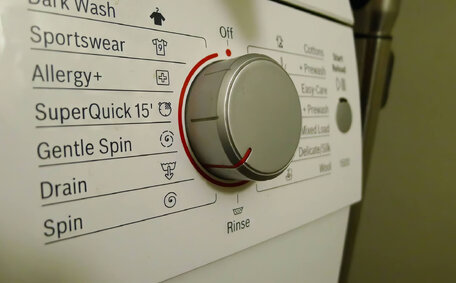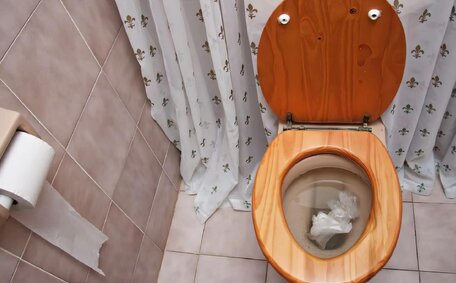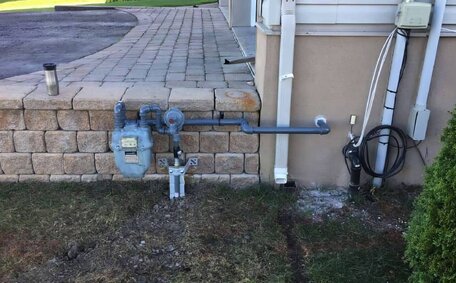Key causes of toilet blockages
p>p>p>
Flushing unsuitable items
Flushing items that aren’t meant to be flushed is one of the most common causes of toilet blockages. Certain items may seem harmless, but can get lodged in pipes and cause major backups.
One of the biggest culprits is disposable wipes, including baby wipes and flushable wipes. Although some wipes are marketed as flushable, they do not break down like toilet paper. The fibres can snag on pipes and accumulate, creating clogs.
Feminine hygiene products such as tampons and pads are also not meant to be flushed. They are designed to absorb liquid and can easily swell up and block pipes. Flushing them can damage your plumbing system.
Other items like children’s toys, dental floss, cotton balls and swabs, condoms, diapers, cigarette butts, and paper towels should always go in the trash instead of the toilet.
Flushing anything other than human waste and toilet paper is asking for trouble. Even some items labelled as flushable can cause issues. When in doubt, throw it out.
Build up of materials
Over time, buildup in pipes can lead to toilet clogs. Grease, oil, and food scraps that go down the drain can stick to pipe walls and restrict flow. Over time, buildup in pipes can lead to toilet clogs.
Eventually, a blockage forms.
Excess hair and fur can tangle together and cause similar issues. As strands collect in pipes, they snag other debris passing through. Masses of hair mixed with grease and waste create a thick blockade.
Using too much toilet paper or flushing the wrong materials also adds to the problem.
Extra tissues and paper towels do not break down well. They absorb water and expand, obstructing the pipes. Extra tissues and paper towels do not break down well.
Hard water and mineral deposits from old pipes contribute too. The calcified scale that forms inside pipes gets thicker over time. Bits of limescale break off and create a foundation for blockages.
Any combination of these factors can gradually obstruct sewer lines and lead to toilet clogs. Practising proper cleaning habits and avoiding flushing unsuitable items helps prevent this buildup.
Issues with low flow toilets
Low-flow toilets are increasingly common in modern homes, but they can contribute to more frequent clogs. These water-saving models use just 6 litres per flush, whereas older toilets use up to 11 litres.
With the reduced water volume, there is less force to push waste through the toilet bowl and pipes. Any extra toilet paper or other debris left behind may get caught in the trap and cause a blockage.
Another issue with some low-flow toilets is weak flush performance. If the flush is not powerful enough, waste can accumulate in the bowl or immediately clog the toilet. Upgrading to a newer low-flow model with enhanced siphonic technology can improve flushing capability.
Low-flow toilets save water, but require extra care to avoid clogs. Using the right amount of toilet paper, being mindful of what gets flushed, and having a plumber install or repair the toilet can help minimise problems.
Blockages in pipes
One of the most troublesome spots for toilet clogs is in the trap built into the toilet’s drain pipe. This U-shaped bend in the pipe is designed to hold water and prevent sewer gases from entering the bathroom. However, it also catches debris easily.
Toilet paper, wipes, hair, and other materials can get snagged in the tight U-bend. Over time, the trap fills with debris and obstructs water and waste from passing through smoothly. A partial or complete clog results, leading to a blocked and gurgling toilet.
Clogs in the toilet trap are often challenging to clear on your own. Chemical drain cleaners may damage the trap and plumbing fixtures. Plunging too vigorously can crack the porcelain.
A plumber has specialised snakes and tools to clear a toilet trap clog without harming the toilet.
For recurring issues, a plumber can also assess the drainage layout and functioning of the toilet trap and vent stack. Ensuring proper pipe slope and venting prevents syphoning and suction issues that make toilet clogs more likely in problematic drain lines.
Preventing toilet blockages
There are several steps you can take to help prevent annoying and messy toilet blockages in your home.
Be choosy about what gets flushed
One of the top things you can do is be very selective about what gets flushed down the toilet. Items like tissues, paper towels, wipes, feminine products, diapers, cotton swabs, dental floss, and condoms should always go in the trash.
Only human waste and toilet paper should go down the toilet. Flushing inappropriate items is a leading cause of toilet clogs.
Use the right amount of toilet paper
It’s important not to use too much toilet paper. Large wads of tissue can get easily clogged in waste pipes.
Stick to a modest amount – a few sheets folded over should suffice. Too much toilet paper in the bowl at once increases the risk of clogging.
Deal with buildup immediately
Don’t allow grease, hair and soap scum to accumulate for long periods. Wipe down sinks and showers regularly to keep hair and oil from going down the drains. Run hot water periodically to melt grease deposits and use enzyme drain cleaners monthly to reduce buildup in pipes.
Upgrade old plumbing fixtures
If you have an outdated toilet, consider replacing it with a newer high-efficiency model. Newer toilets have more effective syphon flushing systems to thoroughly clear waste with each flush. Installation by a professional ensures optimal performance.
Call a plumber for recurring clogs
If your toilet keeps clogging, don’t just keep plunging. There may be an underlying issue needing repair, especially if you have an older home. A plumber can snake drains, clear vent stack obstructions, replace worn toilet parts, and assess your overall drainage system.
Unblocking a toilet
A clogged toilet can be extremely frustrating. With a few simple tools and proper technique, you can often unclog a toilet yourself.
Step 1: Turn off the water supplyLocate the valve behind or near the toilet and turn it clockwise to shut off the water. This prevents overflowing.
Step 2: Plunge the toiletPlace a plunger over the drain hole to form a tight seal. Quickly plunge up and down 10-15 times to loosen the clog. Flush to test if the blockage cleared.
Step 3: Use a closet augerFor stubborn clogs, insert the hooked end of a closet auger down the toilet drain. Crank the handle clockwise while pushing the auger forward then back again to break up the blockage. Remove any dislodged debris.
Step 4: Flush with hot waterPour a pot of hot water directly into the toilet bowl to help dissolve the clog. Wait 10 minutes then flush again.
Step 5: Repeat as neededp>p>p>
When to call a professional
p>p>p>p>p>p>p>p>p>p>p>p>p>p>p>p>p>






